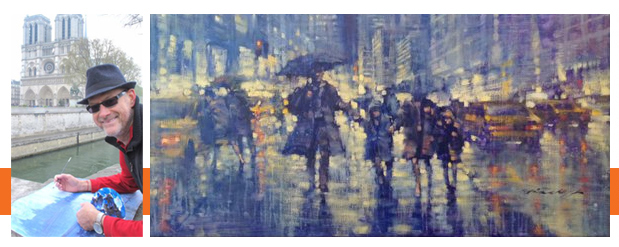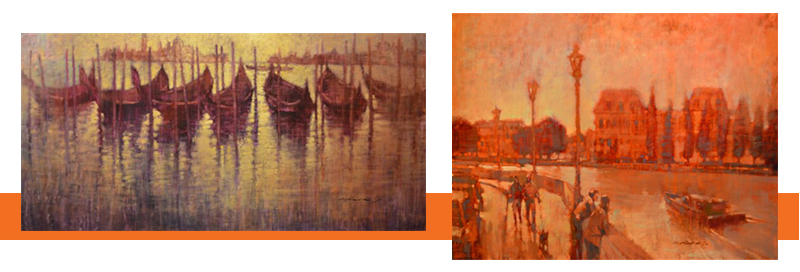David Hinchliffe, retired Brisbane City Councillor, is an exceptional talent whose paintings are based on the streets, laneways, paths and urban settings of cities he loves, including Paris, New York, Venice, and his hometown, Brisbane. Since beginning painting at 12 years old, Hinchliffe has had more than 50 exhibitions throughout his 40-year art career, with his works held in private collections in America, the United Kingdom, and Australia.
 AC: David as a past councillor how hard has it been to change your hat from politician to artist?
AC: David as a past councillor how hard has it been to change your hat from politician to artist?
DH: Six months ago, I would have said the transition would have been almost impossible. But the reality is the change has been instant and painless. That was then. This is now. I haven’t looked back and I certainly don’t miss my old life.
AC: Do you feel that your past profession has influenced you as a painter or your subject matter?
DH: Tennyson said in his epic ‘Ulysses’, “I am a part of all that I have met”. I think that’s essentially true of all of us. Our experiences contribute to making us who we are today. Politics has of course influenced me, but I was an artist before I became a politician and I think my art influenced my politics as much as vice versa. It’s true that the ‘workplace’ for a local government representative is definitely the streets and the suburbs where your community lives and perhaps that’s why most of my current painting material is about streetscapes – so there is an overlap.
AC: How do you choose your subject matter and decide on a final composition?
DH: My subjects are largely the streets of suburbs and cities I love, so in a sense they choose themselves. What I look for is the play of light on the shapes and forms that inhabit streets.
AC: Who or what inspired you to first pick up the paintbrush?
DH: My father painted as a young man and I’d have to say he was my first influence, but the French painters of the late 19th century were the ones who really excited my interest in the possibilities of paint. An Australian influence has definitely been Jeffrey Smart because of the way he has taught us to view the ordinary as extraordinary.
AC: Have you always painted the urban environment? What draws you to paint these scenes, what are you trying to capture?
DH: My earlier work was a combination of figurative and landscape and I still do work in both those subjects. I’ve cruised through a range of themes over 30 years of painting and I’ve happily landed on the subject matter of streetscapes as my true painter’s passion. I love the buzz and noise of cities and the play of both natural light and artificial light on the streetscape.
AC: The current exhibition contains paintings of Venice, Paris, New York, Melbourne and Brisbane, why these cities and which is your favourite?
DH: The former politician in me suggests I should say Brisbane and certainly our city’s streets have their special light and charm, but how could anyone overlook the obvious pure beauty of Venice and Paris? I once rejected the notion of artists painting beautiful things. I convinced myself that artists had to shine a light on the dark underbelly of society. I’m happy to say I no longer have those angst-ridden pretensions. I think there’s nothing wrong in celebrating beauty.
AC: Do you have a particular process to get you into the ‘creative zone’?
DH: Deadlines certainly help spur me on, but good music is an obvious incentive. Gershwin gets me into a New York state of mind, while Vivaldi makes me think of Venice and Piaf and Monsieur Camembert transport me immediately to the streets of Paris.
AC: What music do you listen to while you paint?
DH: When it’s not Gershwin, Vivalid, Piaf or others, I’m happy listening to my son’s band Kooii, who play a combination of jazz/reggai/fusion.
AC: Putting together the body of work for this exhibition must have taken up a lot of your time, what direction would you like to take your art?
DH: My art has taken a course all its own. I’m delighted after 25 years of hard work as a Councillor to contemplate spending the rest of my life painting full-time. I just feel that I have so much painting, sketching and sculpting in me that I really look forward to devoting myself to that.
AC: What does your art mean to you?
DH: What it means to me is really what it means to the people who buy it. The positive response my work receives from buyers is such a change from life as a Councillor when the only people you hear from are your critics.
AC: In one sentence describe your art to our readers.
DH: I take what I see and re-interpret it.
AC: What is your favourite childhood memory?
DH: When we lived in Brisbane and drove back home to spend weekends with my grandparents in Toowoomba.
AC: I’ve heard you drive a scooter, why and what colour is it?
DH: My retirement promise to myself was to buy a red scooter…the sort of thing no self-respecting Councillor would be seen dead on.
AC: Share something about yourself that might surprise our readers
DH: I am too discreet to divulge any secrets – that should surprise some readers!
AC: Finally who are your top three favourite artists?
DH: I hate being so predictable but my favourite Australian artist would have to be Brett Whitley and, equally predictably the greats, Vincent Van Gogh and Pablo Picasso.
 Exhibiting July 2012 at Red Hill Gallery – View the exhibition online here.
Exhibiting July 2012 at Red Hill Gallery – View the exhibition online here.



